From daily life to cutting-edge technology, accurate measurement using units is indispensable. The "Metre Convention" aimed at international standardization was signed in 1875 and marked its 150th anniversary on the 20th of May. To commemorate this, the National Institute of Advanced Industrial Science and Technology (AIST), which promotes measurement standards and international cooperation, showed the "Japan national kilogram prototype" and "Japan national meter prototype" to the press. For many years, these were the standards for weight and length in Japan. This simultaneous public display is the first of its kind. The person in charge emphasized, "Measurement standards are like a common language for humanity, a major achievement brought about by science and technology."
Two "Prototypes" supporting life, industry, and science and technology
"Our predecessors paid meticulous attention and continued to protect these. As the current manager, I am tremendously proud."
In a room at AIST in Tsukuba City, Ibaraki Prefecture, Chief Researcher Naoki Kuramoto of the National Metrology Institute of Japan (NMIJ), spoke these words and then led reporters through a heavy, locked door. A historic safe with a golden plaque engraved with "Imperial Japanese Measurement Standards" was placed prominently at the front, its interior lined with paulownia wood. Inside a double glass container sat a silver weight, 3.9 centimeters in both diameter and height. This is the kilogram prototype, a one-kilogram platinum and iridium alloy.
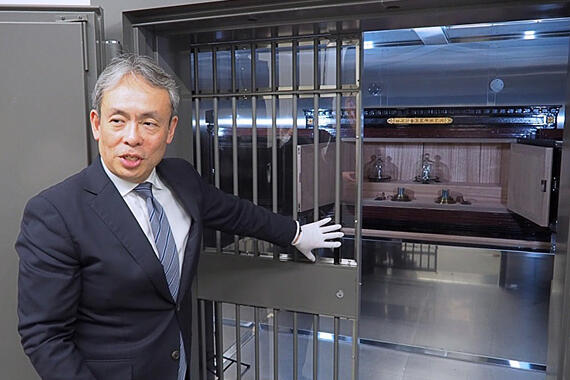
Using paulownia wood regulates humidity and prevents mold. The room housing the safe maintains humidity at nearly 0%. The kilogram prototypes distributed to various countries are gathered and checked approximately every 40 years, but Japan's shows an extremely small mass change compared with other countries. In some countries, they are apparently simply stored in lockers. Hearing this, Kuramoto's opening words gain more resonance. Strictly maintaining measurement standards is indispensable for life, industry, and science and technology. The excellent preservation condition of the kilogram prototype seems to tell a story of how Japanese people have strongly held this recognition throughout modern and contemporary times.
Kuramoto noted, "The kilogram prototype was also an important intellectual foundation for Japan, a modernizing nation that was introducing and developing through Western scholarship and science and technology. The fact that Japan participated in the Metre Convention much earlier than other Asian countries also sheds light on Japan's strategy."
The meter prototype was also shown in a separate room. It was a rod 1.02 meters long with a cross-section in the shape of an "X," also made of a platinum and iridium alloy. Measurement lines were engraved on its surface indentations, with the interval between both ends being exactly one meter. The "X" shape was adopted because it is resistant to bending and has a large surface area that easily adapts to temperature. The reporters, including this writer, were uniformly struggling to photograph the minute markings at both ends.
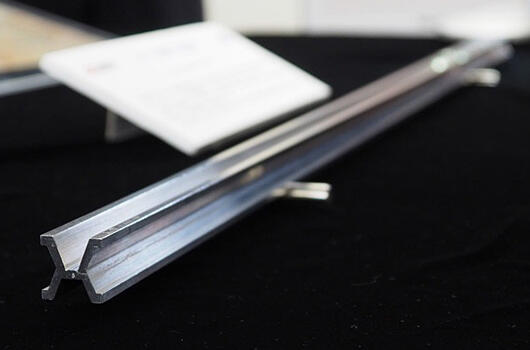
Both the meter prototype and kilogram prototype are no longer standards due to revisions in the definitions, so they were designated as National Important Cultural Properties in 2012 and 2022 respectively.
Transition to "universal standards"
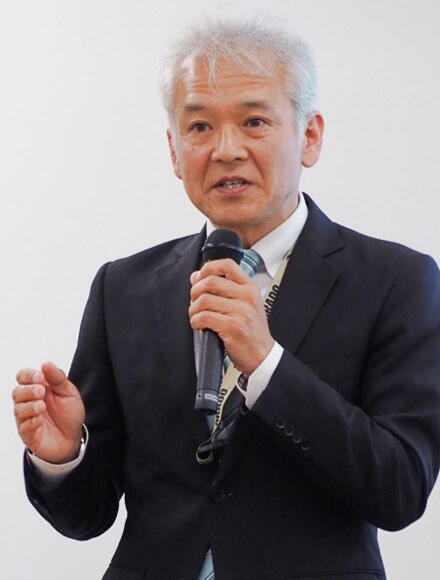
"If the size of measuring units varied by region, it might be fine within that region, but it would cause major problems when interacting with distant people. Or, if a lord reduced the measuring unit during a poor harvest year to collect taxes, he might be remembered as a friend of farmers, but it wouldn't be entirely good. The Metre Convention was established 150 years ago to unify units that were scattered across countries and regions and spread them globally," said Group Leader Takehiro Morioka of the NMIJ International Cooperation Office at AIST, explaining the fundamental necessity of measurement standards.
Mass and length definitions changed with the advancement of science and technology, increasing reliability. In late 18th-century France, 1 kilogram was initially defined as the mass of 1 liter of water, but after the Metre Convention in 1889, the "international kilogram prototype" was created. This was managed by the International Bureau of Weights and Measures in France, which distributed copies of the kilogram prototype to treaty member countries like Japan.
Around 1990, it was discovered that the mass of the international kilogram prototype might have slightly changed due to surface contamination. In response, it was decided to use universal physical constants independent of human-made objects. The "Planck constant," the smallest unit of light energy, was chosen as the standard, and after precise measurements by institutions like AIST, it was adopted in 2019. Thus, the kilogram prototype was removed from the definition but is still used as one of the highest-precision weights in the country.
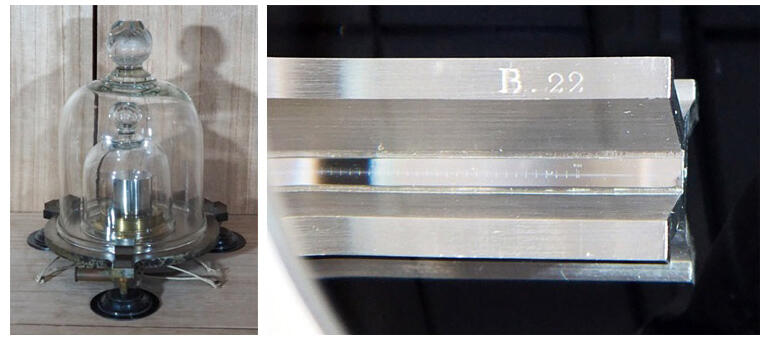
Interference with surveys, arrests... A history of hardship
Meanwhile, 1 meter was first defined in 1795 as "one ten-millionth of the arc of the meridian between the North Pole and the Equator." After the Metre Convention went into effect, it was revised in 1889 to "the distance between two scale lines of the international meter prototype at zero degrees temperature." One of the distributed copies became Japan's meter prototype. Subsequently, following the same logic as mass, and moving away from human-made objects, it changed in 1960 to the wavelength of light, specifically "1,650,763.73 times the wavelength of krypton-86 under certain conditions." In 1983, it was further amended to "the distance light travels in 1/299,792,458 of a second in a vacuum," which remains the current definition.

What's truly fascinating in the history of the meter is its 1795 definition. In France, with a rising momentum for "a unit system usable everywhere," they decided to use the meridian as a reference. In reality, they didn't measure between the North Pole and Equator but measured the distance between two points with a 10-degree latitude difference and multiplied by nine. Even so, these two points were about 1,100 kilometers apart. "With the French Revolution (1789-99) as a backdrop, the surveys were extremely challenging. They faced interference and arrests due to political suspicions, and it took six years," explained Group Leader Yasuaki Hori at AIST's NMIJ.
Why did people at the time go to such lengths for such a massive survey? Why couldn't they adopt something small like the meter prototype? When asked, Hori responded: "I think it was incredibly challenging. However, there was a philosophy of using natural objects like the Earth as a reference, not artificial objects. Moreover, surveying technology was highly developed at the time, with France particularly focused on this. The revolution's high ideals also contributed to the success of such a project." It was a dramatic moment in scientific history.
Spread of Measurement Standards: "A major achievement in science and technology"
The metric system was established to organize measurement foundations and promote global standardization of unit systems and was signed by 17 countries in Paris on May 20, 1875. This led to the establishment of a general assembly of member countries and the International Bureau of Weights and Measures to internationally spread standards for weights and measures (length, volume, mass). Japan joined the treaty ten years later in 1885 and fully implemented the metric system in 1959, except for land and building descriptions. Currently, 101 countries are members, including associate members.
In the same year the Metre Convention was established, 1875, Japan also published the Weights and Measures Control Ordinance to unify standards of length, volume, and mass across regions, establishing units like "shaku" for length and "monme" for mass. This was the predecessor to the current Measurement Act. By coincidence, this was the year both the world and Japan took their first steps toward measurement standardization.
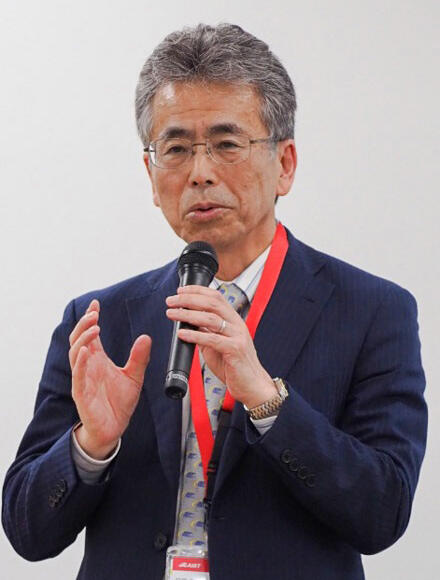
By 1971, the International General Conference of Weights and Measures established the International System of Units (SI) with seven base units: second, meter, kilogram, ampere, kelvin, mole, and candela. In 1999, May 20, the day of the Metre Convention's signing, was designated World Metrology Day. This year marks the 150th anniversary of the treaty, and a commemorative ceremony will be held in Paris on that day.
Director General of Takashi Usuda of AIST's NMIJ and secretary of a committee under the International General Conference of Weights and Measures, states: "Measurement standards are like a common language for mutual understanding transcending time, culture, and nations. The fact that they have been accepted based on the trust that 'they are definitely accurate' is a major achievement of science and technology. The Metre Convention is perhaps one of the most successful international treaties."
We go about our daily lives constantly measuring - checking "how many minutes' walk to the station" when we go to work or school, feeling disappointed about reduced snack volumes in "shrinkflation," lamenting the rising prices of gasoline and rice... Our lives are filled with units and measurements. On the 150th anniversary of the treaty, examining our lives and society through these familiar acts of measuring seems quite intriguing.
(KUSAKA Takeo / Science Portal Editorial Department)
Original article was provided by the Science Portal and has been translated by Science Japan.




